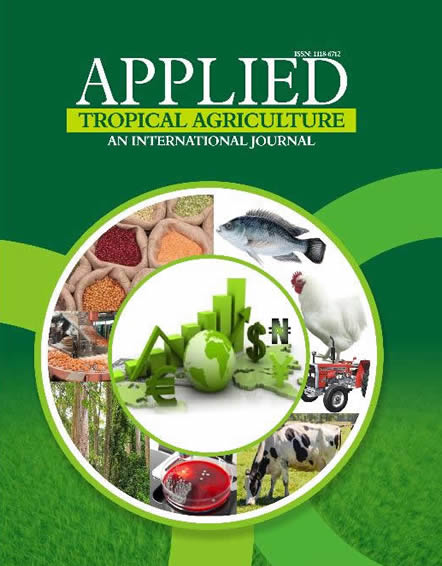The growth of maize (Zea mays .L) in response to varying organic and inorganic fertilizer treatment was investigated in Akure,
Nigeria. The fertilizer treatments include cow manure; goat manure; pig manure; poultry manure; cow manure + NPK; goat
manure + NPK; pig manure NPK and poultry manure NPK. The experiment was laid out in a completely randomized design
(CRD) with five replicate per treatment. Growth data (plant height and collar diameter) were collected at 2 ,4 and 6 weeks after
planting (WAP) and analysed by one-way analysis of variance at 5% level of significance. Duncan Multiple Range Test was
used to separate the significant means. Growth of maize with respect to height and collar diameter varied significantly with the
fertilizer treatment types compared to control and even among the fertilizer type. At 6WAP, application of poultry manure alone
resulted to maize plants with significantly higher height (91.80 cm) and collar diameter (19.83 cm) growth compared to all
other fertilizer treatments. Consistently, the animal manure applied either singly or combined with NPK resulted to higher plant
height and collar diameter than that of NPK fertilizer alone treatment which were 31.40 cm for plant height, 1.46 cm for collar
diameter at 4WAP and 61.0 for plant height, 1.69 cm for collar diameter at 6WAP. The control (no input) produced maize plants
with significantly lower height and diameter growth which were 18.0 cm for plant height, 0.93 cm for collar diameter at 4WAP
and 28.50 cm for plant height, 1.28 cm for collar diameter at 6WAP compared to those that received one form of fertilizer or the
other. The future requires that famers will farm the same piece of land continuously and will be faced with the challenge to
increase food production on lands that are already in cultivation. This has to be done in a way that does not lead to diminished
soil productivity. Combined mineral and organic fertilizer is therefore required for sustainable soil productivity under intensive
cultivation
PAPER TITLE :GROWTH OF MAIZE (ZEA MAYS. L) IN RESPONSE TO VARYING ORGANIC AND INORGANIC FERTILIZER TREATMENT
APPLIED TROPICAL AGRICULTURE | VOLUME 20 NUMBER 2 2015
Paper Details
- Author(s) : Oyun, M.B.1 Fasinmirin J.2; Olufolaji, O.O.3 and Ogunrinde, O.S.1
- Abstract:


